Abstract
A role for alpha beta and gamma delta T cells in protection against primary and secondary infection with Listeria monocytogenes was studied. The results show that mice depleted of either gamma delta T cells with 3A10 monoclonal antibody (mAb), or alpha beta T cells with anti-CD4 plus anti-CD8 mAb, or both types of T cells, remained capable of controlling Listeria multiplication during the first 4 days of primary sublethal infection. Moreover, mice depleted of either or both types of T cells also remained capable of resolving primary infection, although the absence of alpha beta T cells, but not gamma delta T cells, caused resolution to be slower. Likewise, Listeria-immune mice depleted of either alpha beta or gamma delta T cells remained capable of resolving secondary infection with a large inoculum of L. monocytogenes, although depletion of alpha beta T cells, and to a much lesser extent gamma delta T cells, resulted in early exacerbation of infection. However, immune mice depleted of both types of T cells lost their ability to resist a lethal Listeria challenge. Taken together, the results show that whereas neither type of T cell is needed for resistance to sublethal primary listeriosis, alpha beta T cells may act in concert with gamma delta T cells in protecting mice against lethal secondary infection. In addition, the results indicate that the role of gamma delta T cells in anti-Listeria resistance is much less important than the role of alpha beta T cells, and can be demonstrated mainly in the absence of alpha beta T cells.
Full text
PDF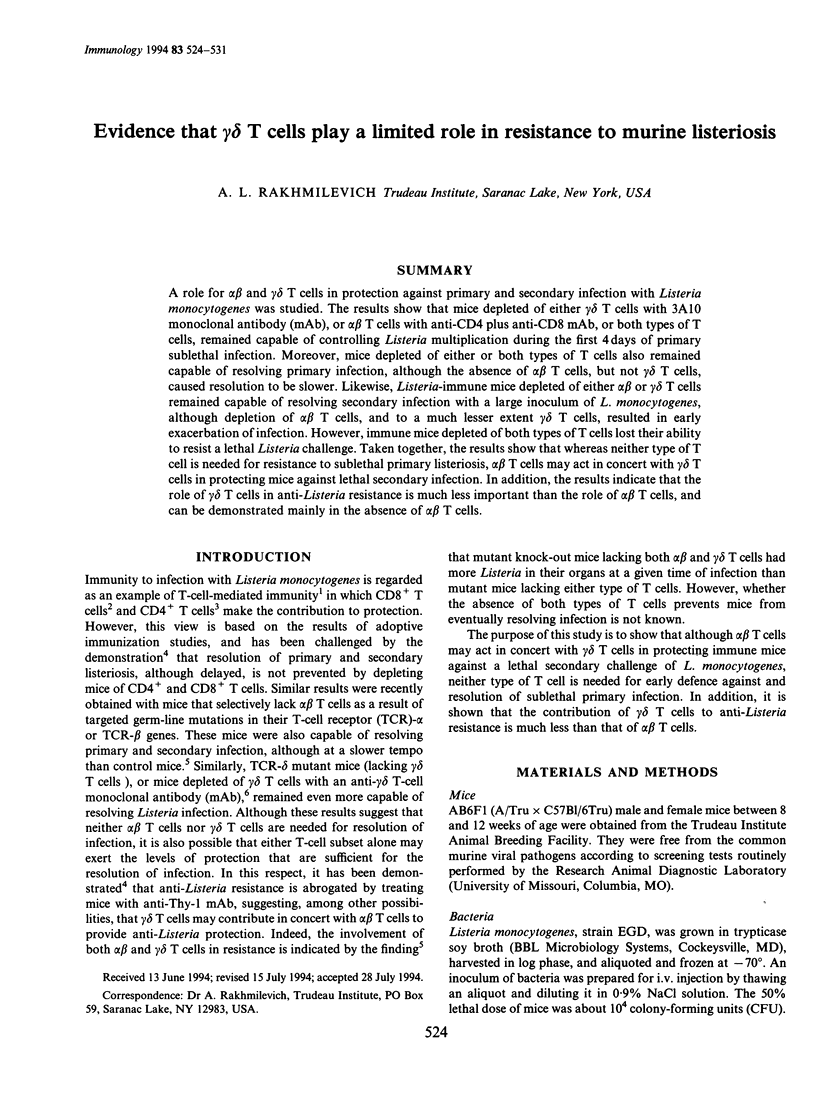
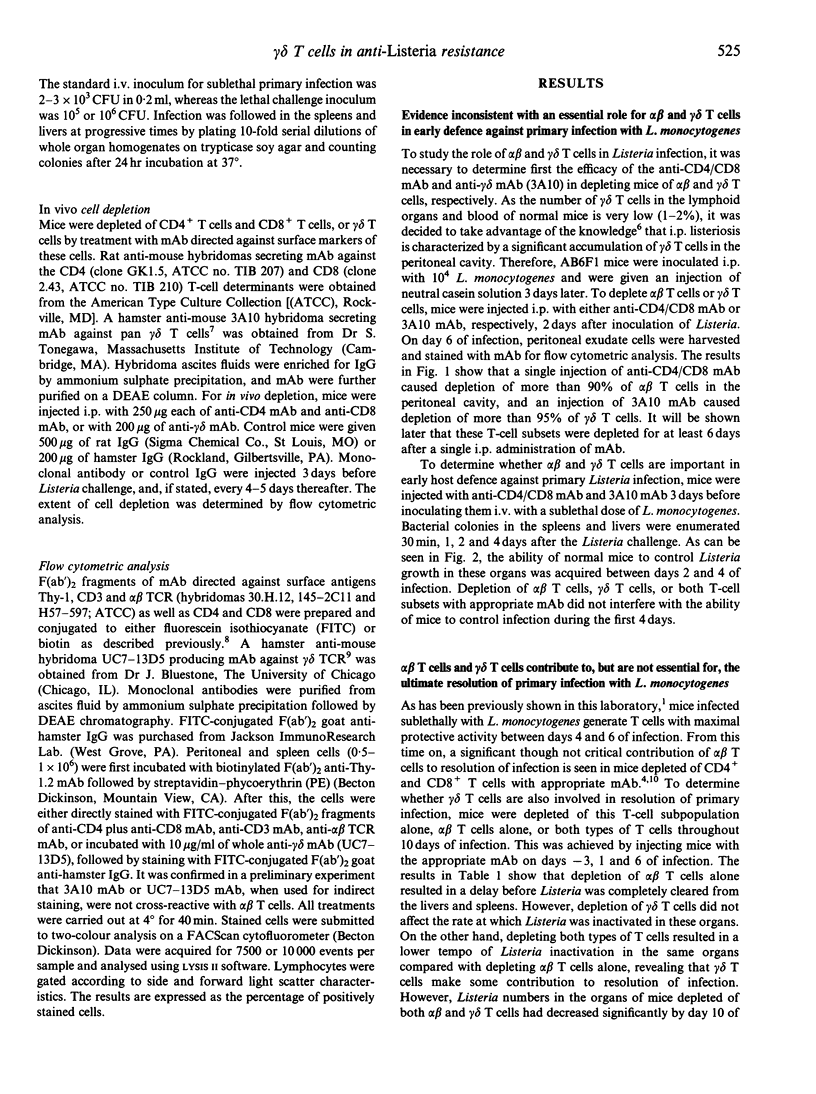
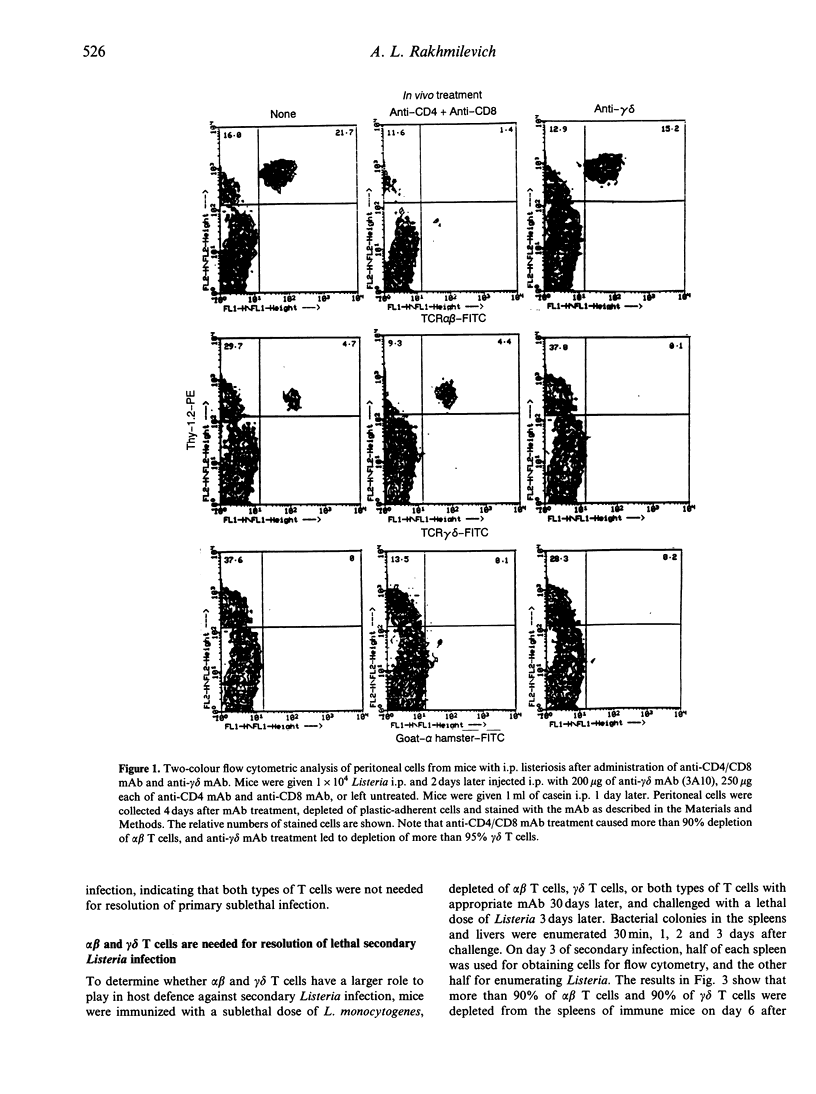

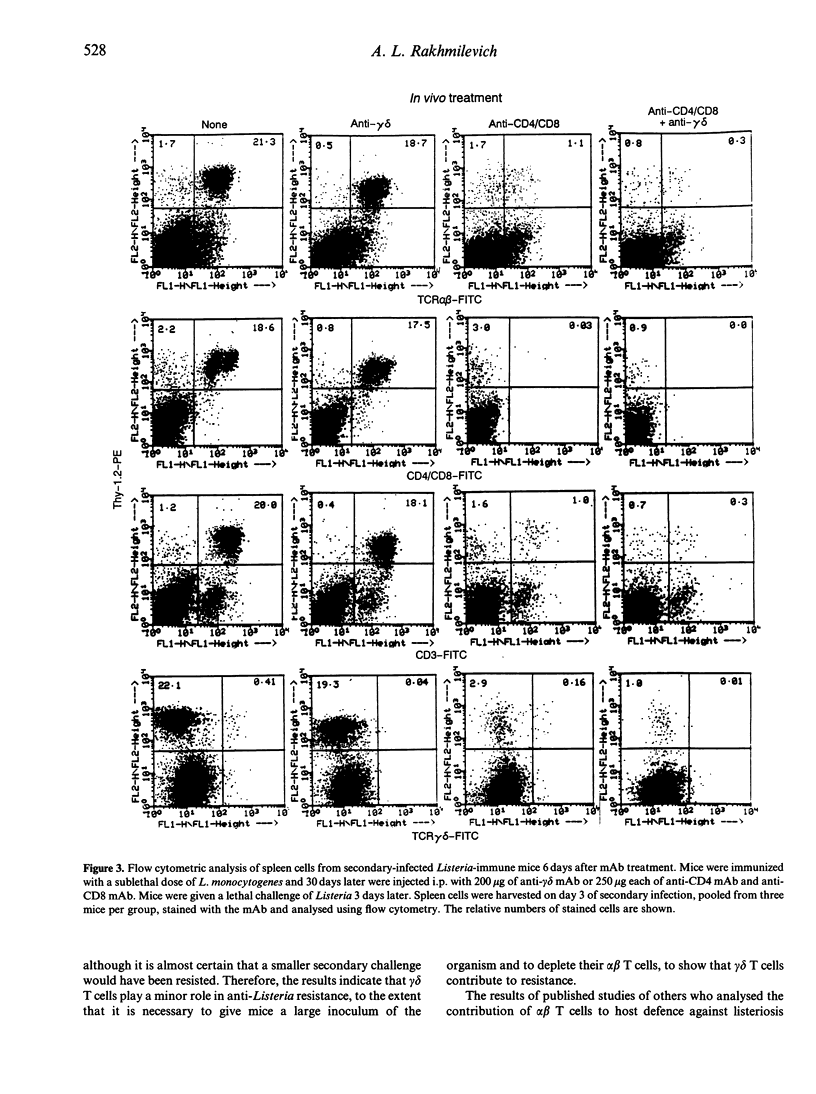
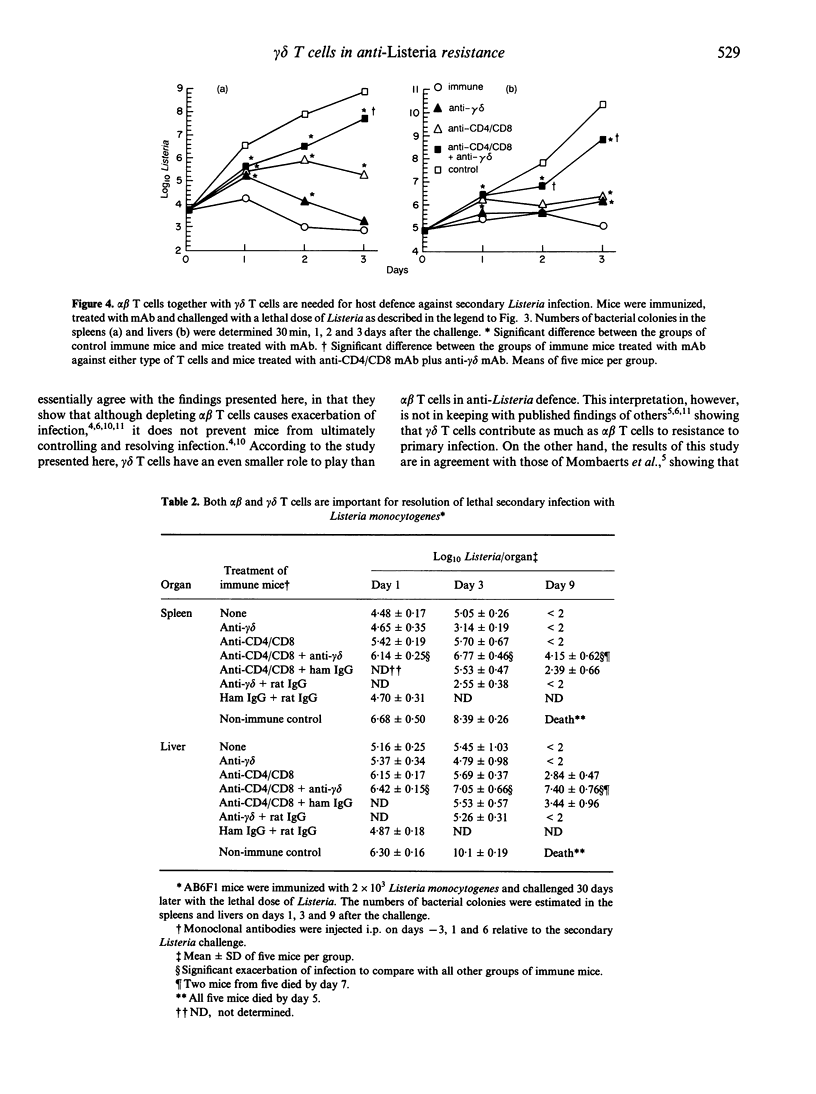
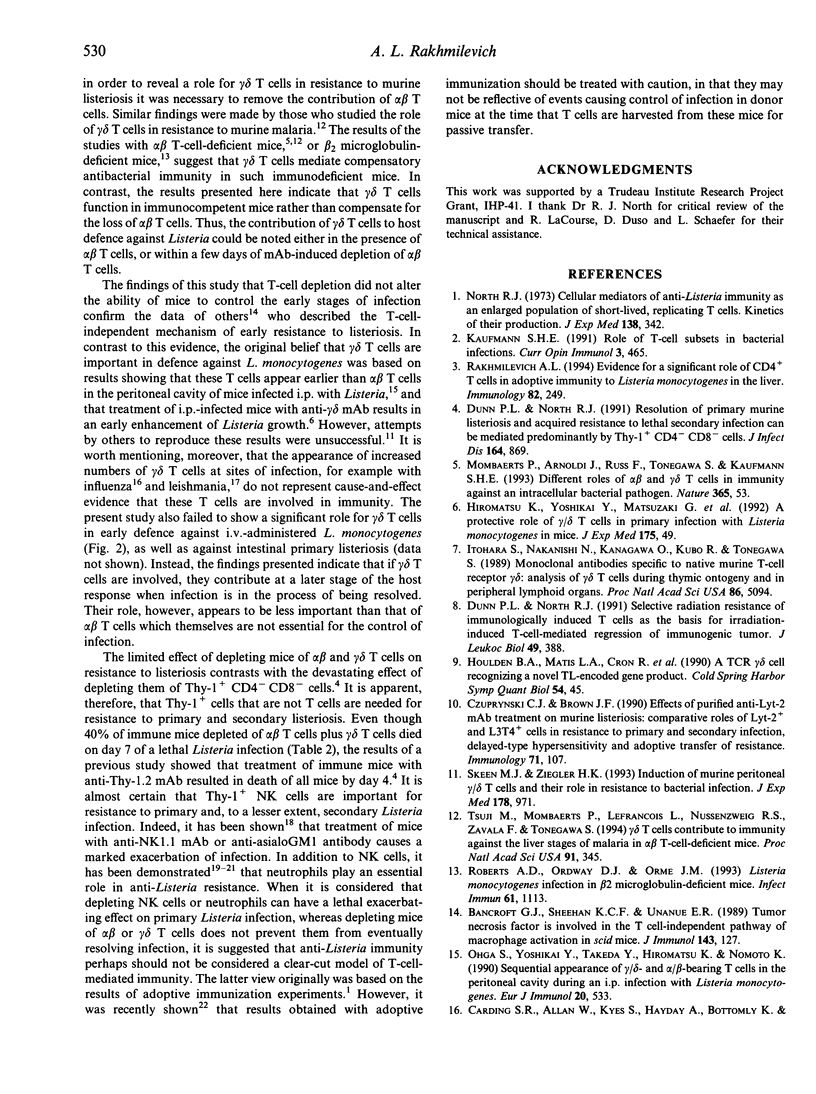
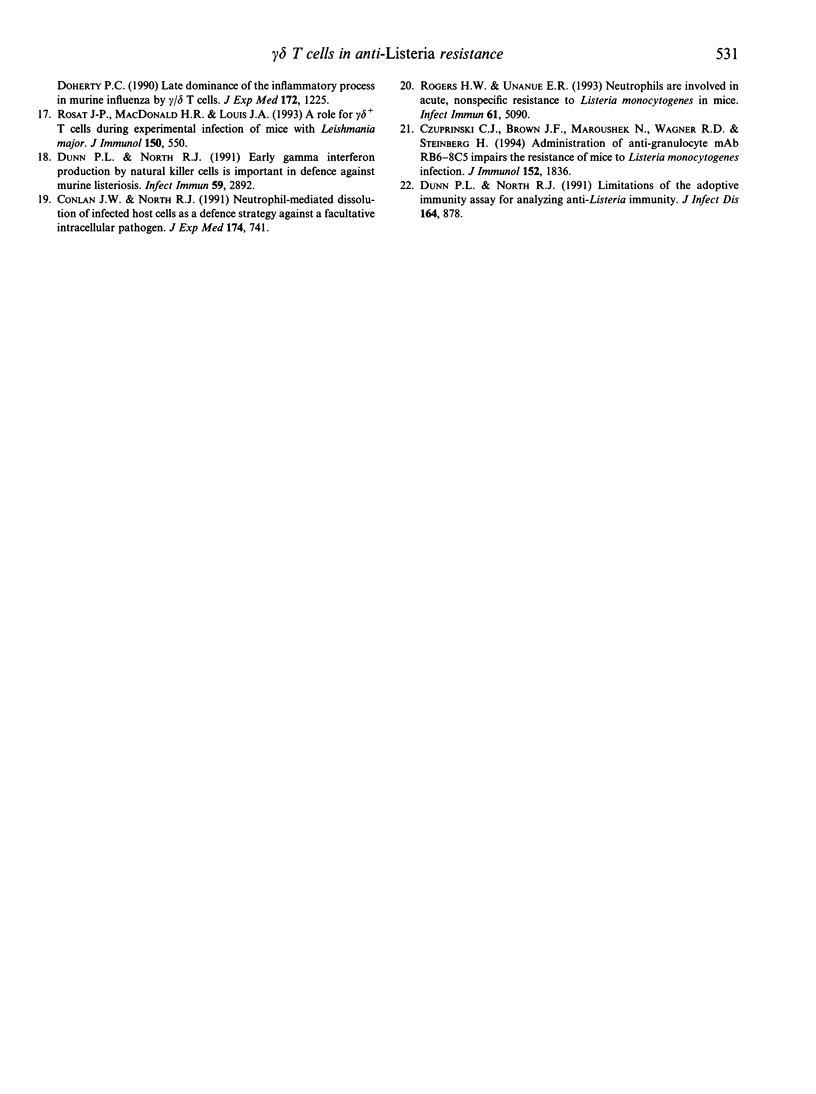
Selected References
These references are in PubMed. This may not be the complete list of references from this article.
- Bancroft G. J., Sheehan K. C., Schreiber R. D., Unanue E. R. Tumor necrosis factor is involved in the T cell-independent pathway of macrophage activation in scid mice. J Immunol. 1989 Jul 1;143(1):127–130. [PubMed] [Google Scholar]
- Carding S. R., Allan W., Kyes S., Hayday A., Bottomly K., Doherty P. C. Late dominance of the inflammatory process in murine influenza by gamma/delta + T cells. J Exp Med. 1990 Oct 1;172(4):1225–1231. doi: 10.1084/jem.172.4.1225. [DOI] [PMC free article] [PubMed] [Google Scholar]
- Conlan J. W., North R. J. Neutrophil-mediated dissolution of infected host cells as a defense strategy against a facultative intracellular bacterium. J Exp Med. 1991 Sep 1;174(3):741–744. doi: 10.1084/jem.174.3.741. [DOI] [PMC free article] [PubMed] [Google Scholar]
- Czuprynski C. J., Brown J. F. Effects of purified anti-Lyt-2 mAb treatment on murine listeriosis: comparative roles of Lyt-2+ and L3T4+ cells in resistance to primary and secondary infection, delayed-type hypersensitivity and adoptive transfer of resistance. Immunology. 1990 Sep;71(1):107–112. [PMC free article] [PubMed] [Google Scholar]
- Czuprynski C. J., Brown J. F., Maroushek N., Wagner R. D., Steinberg H. Administration of anti-granulocyte mAb RB6-8C5 impairs the resistance of mice to Listeria monocytogenes infection. J Immunol. 1994 Feb 15;152(4):1836–1846. [PubMed] [Google Scholar]
- Dunn P. L., North R. J. Early gamma interferon production by natural killer cells is important in defense against murine listeriosis. Infect Immun. 1991 Sep;59(9):2892–2900. doi: 10.1128/iai.59.9.2892-2900.1991. [DOI] [PMC free article] [PubMed] [Google Scholar]
- Dunn P. L., North R. J. Limitations of the adoptive immunity assay for analyzing anti-Listeria immunity. J Infect Dis. 1991 Nov;164(5):878–882. doi: 10.1093/infdis/164.5.878. [DOI] [PubMed] [Google Scholar]
- Dunn P. L., North R. J. Resolution of primary murine listeriosis and acquired resistance to lethal secondary infection can be mediated predominantly by Thy-1+ CD4- CD8- cells. J Infect Dis. 1991 Nov;164(5):869–877. doi: 10.1093/infdis/164.5.869. [DOI] [PubMed] [Google Scholar]
- Dunn P. L., North R. J. Selective radiation resistance of immunologically induced T cells as the basis for irradiation-induced T-cell-mediated regression of immunogenic tumor. J Leukoc Biol. 1991 Apr;49(4):388–396. doi: 10.1002/jlb.49.4.388. [DOI] [PubMed] [Google Scholar]
- Hiromatsu K., Yoshikai Y., Matsuzaki G., Ohga S., Muramori K., Matsumoto K., Bluestone J. A., Nomoto K. A protective role of gamma/delta T cells in primary infection with Listeria monocytogenes in mice. J Exp Med. 1992 Jan 1;175(1):49–56. doi: 10.1084/jem.175.1.49. [DOI] [PMC free article] [PubMed] [Google Scholar]
- Houlden B. A., Matis L. A., Cron R. Q., Widacki S. M., Brown G. D., Pampeno C., Meruelo D., Bluestone J. A. A TCR gamma delta cell recognizing a novel TL-encoded gene product. Cold Spring Harb Symp Quant Biol. 1989;54(Pt 1):45–55. doi: 10.1101/sqb.1989.054.01.006. [DOI] [PubMed] [Google Scholar]
- Itohara S., Nakanishi N., Kanagawa O., Kubo R., Tonegawa S. Monoclonal antibodies specific to native murine T-cell receptor gamma delta: analysis of gamma delta T cells during thymic ontogeny and in peripheral lymphoid organs. Proc Natl Acad Sci U S A. 1989 Jul;86(13):5094–5098. doi: 10.1073/pnas.86.13.5094. [DOI] [PMC free article] [PubMed] [Google Scholar]
- Kaufmann S. H. Role of T-cell subsets in bacterial infections. Curr Opin Immunol. 1991 Aug;3(4):465–470. doi: 10.1016/0952-7915(91)90004-k. [DOI] [PubMed] [Google Scholar]
- North R. J. Cellular mediators of anti-Listeria immunity as an enlarged population of short lived, replicating T cells. Kinetics of their production. J Exp Med. 1973 Aug 1;138(2):342–355. doi: 10.1084/jem.138.2.342. [DOI] [PMC free article] [PubMed] [Google Scholar]
- Ohga S., Yoshikai Y., Takeda Y., Hiromatsu K., Nomoto K. Sequential appearance of gamma/delta- and alpha/beta-bearing T cells in the peritoneal cavity during an i.p. infection with Listeria monocytogenes. Eur J Immunol. 1990 Mar;20(3):533–538. doi: 10.1002/eji.1830200311. [DOI] [PubMed] [Google Scholar]
- Rakhmilevich A. L. Evidence for a significant role of CD4+ T cells in adoptive immunity to Listeria monocytogenes in the liver. Immunology. 1994 Jun;82(2):249–254. [PMC free article] [PubMed] [Google Scholar]
- Roberts A. D., Ordway D. J., Orme I. M. Listeria monocytogenes infection in beta 2 microglobulin-deficient mice. Infect Immun. 1993 Mar;61(3):1113–1116. doi: 10.1128/iai.61.3.1113-1116.1993. [DOI] [PMC free article] [PubMed] [Google Scholar]
- Rogers H. W., Unanue E. R. Neutrophils are involved in acute, nonspecific resistance to Listeria monocytogenes in mice. Infect Immun. 1993 Dec;61(12):5090–5096. doi: 10.1128/iai.61.12.5090-5096.1993. [DOI] [PMC free article] [PubMed] [Google Scholar]
- Rosat J. P., MacDonald H. R., Louis J. A. A role for gamma delta + T cells during experimental infection of mice with Leishmania major. J Immunol. 1993 Jan 15;150(2):550–555. [PubMed] [Google Scholar]
- Skeen M. J., Ziegler H. K. Induction of murine peritoneal gamma/delta T cells and their role in resistance to bacterial infection. J Exp Med. 1993 Sep 1;178(3):971–984. doi: 10.1084/jem.178.3.971. [DOI] [PMC free article] [PubMed] [Google Scholar]
- Tsuji M., Mombaerts P., Lefrancois L., Nussenzweig R. S., Zavala F., Tonegawa S. Gamma delta T cells contribute to immunity against the liver stages of malaria in alpha beta T-cell-deficient mice. Proc Natl Acad Sci U S A. 1994 Jan 4;91(1):345–349. doi: 10.1073/pnas.91.1.345. [DOI] [PMC free article] [PubMed] [Google Scholar]


